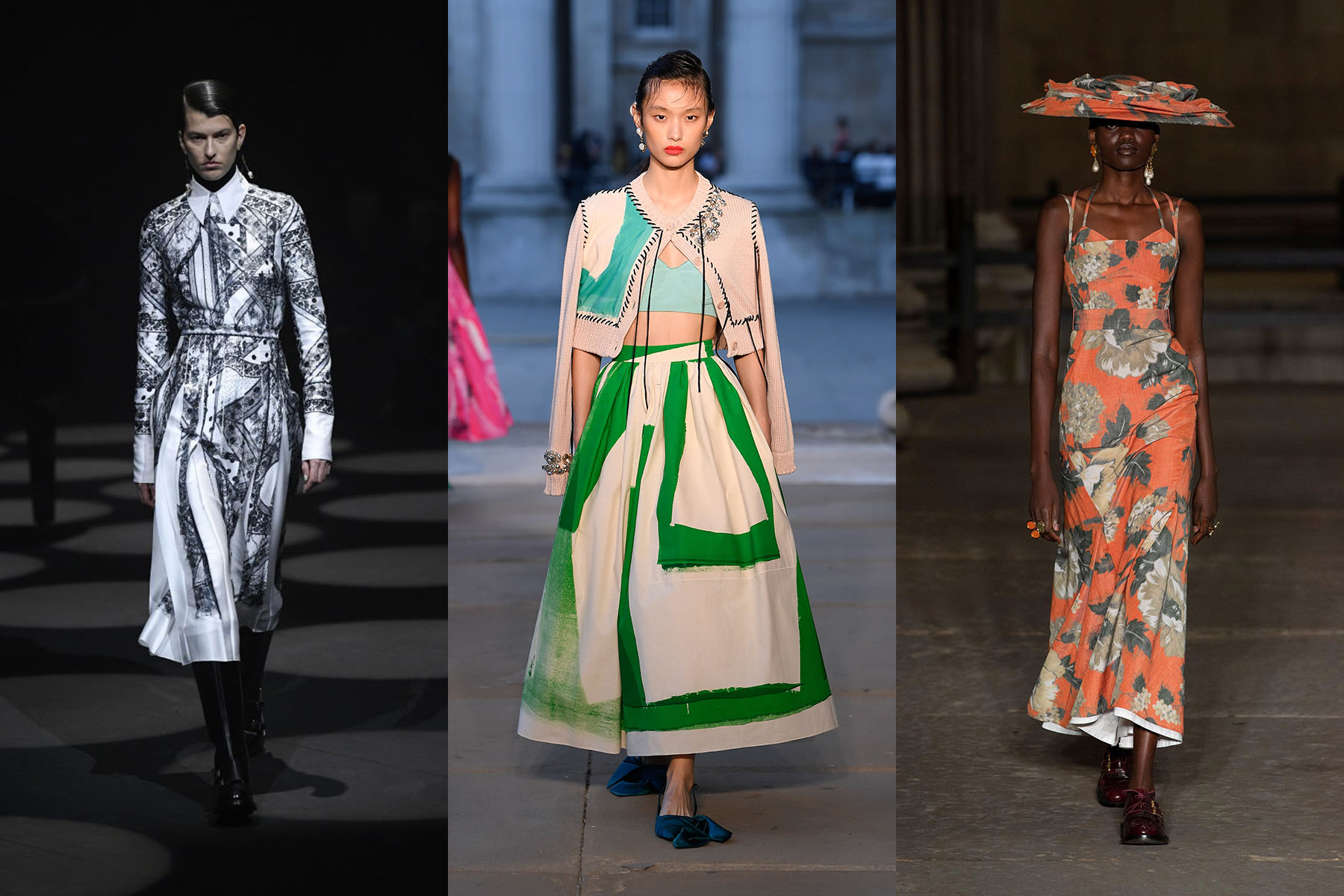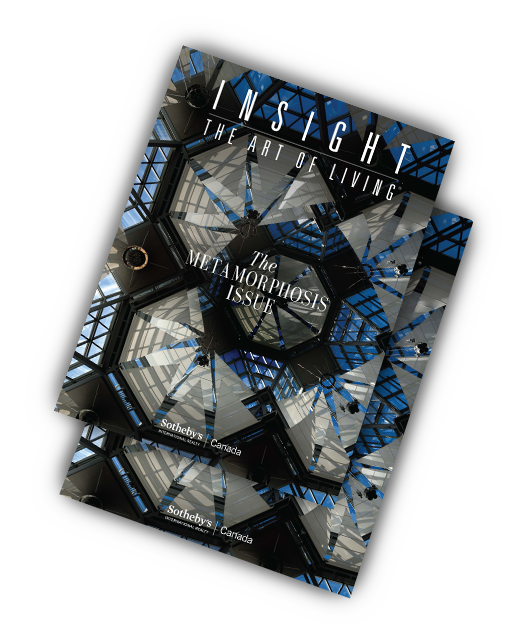Long before Coco Chanel opened her atelier’s doors on Paris’ Rue Cambon in 1910, women flocked to designer boutiques in the hopes of personifying their preferred brand’s style DNA. To wear Chanel is to embody classic French luxury. Slipping on a Diane von Furstenberg wrap dress is symbolic of career success. Donning Ralph Lauren is synonymous with all-American elegance. Because at their core, the best designers are dream makers who create and perpetuate fantasies replete with whimsy and magic, tantalizing consumers with the infinite possibility of becoming someone else.

For Montréal-born Erdem Moralioglu’s eponymous label Erdem, this metamorphosis is different. While the 19-year-old, London-based, ready-to-wear brand is renowned for its signature floral prints, precise tailoring and romantic silhouettes, Erdem’s oeuvre is one of continual evolution. Rather than repeatedly tapping into a fixed look, the British-Turkish designer seeds each collection with an inspiration that is, more often than not, rooted in the spirit and stories of powerful women. The essence of these period characters is then delicately spun through every design until it becomes the fashion house’s next seasonal story.
“He’s a real narrator, like a real storyteller,” affirms Susie Sheffman, a creative director and the former fashion director for FASHION magazine. “He weaves together all of these kinds of disparate historical and cultural references, literary references, and then he creates a muse or a character.
Whatever he’s inspired by — and it could be something that he saw at the National Portrait Gallery in London, or it could be a Greek vase, or Maria Callas, or the Queen of England — he then extrapolates and mixes these influences together. And then, [he] dreams about what her perfect wardrobe would be.”

Over the years, these muses have ranged from photographers and writers to dancers and painters, and even the aristocracy. The late Italian-American photographer Tina Modotti’s 1920s and ’30s series capturing class solidarity among Mexican workers was channelled into Moralioglu’s Spring-Summer 2020 collection of flat-brimmed hats and bright, multi-coloured floor-length dresses with puffed sleeves. Susan Sontag’s historical novel The Volcano Lover, which explores the 18th-century love triangle between Emma Hamilton, Sir William Hamilton and Lord Nelson, influenced the following year’s cropped jackets and asymmetric skirts sprinkled with mismatched prints. Five progressive artists from the 1930s Weimar era — Austrian fashion photographer Madame d’Ora, and German dancers and painters Anita Berber, Valeska Gert, Jeanne Mammen and Elfriede Lohse-Wächtler — were evoked via jacquard dresses, fringed flapper-style hemlines, lacy gowns and the carbon-black bustiers Moralioglu presented in the Fall-Winter 2022 line.
His leaning towards unconventional, powerful women as muses likely stemmed from his relationships with his late grandmothers and mother, and his twin sister Sara. He has even, in past media interviews, referenced his great-grandmothers as inspirations for his creativity. These bold leading ladies are, however, almost contradictory to the softness of the clothes themselves. While Moralioglu designs everything from trench coats to trousers, he’s renowned for his floral dresses. Exquisitely fashioned with mixed textiles and embellishments, they are often delicate and ethereal, sometimes prim and garden party-ish, yet always elegant and feminine. As a curious juxtaposition to the women whose stories narrate the designs, Moralioglu’s dreamy craftsmanship underpins the strength of their character.
“He’s a gay man,” notes Nicholas Mellamphy, the creative director for Hudson’s Bay’s luxury retail space, The Room. “We’re totally enamoured by unconventional women that kind of break with the norms. The women that are icons to the gay community are all slightly different. They don’t conform to the rules, for the most part. His clothes are strong and powerful, and they’re still feminine. [They’re] for a woman with that kind of profile. It’s actually a very beautiful kind of symbiotic marriage of those two elements.”

It makes sense that the women who gravitate towards and don the label are equally complex. Kate Middleton, whose style favourites range from Alessandra Rich to Alexander McQueen, wore an elegant mid-length Erdem skirt suit at Westminster Abbey’s Commonwealth celebrations last year. Crafted in navy blue with a delicate white floral pattern, the ensemble was a departure from the Princess of Wales’ formal coat dresses. The tailored corset-like peplum jacket and its matching skirt with a flared hem fluttered a peek at the white-with-navy floral fabric lining as she walked. It was a combination of pretty and, in royal tradition, composed. It wasn’t the Princess’ first time in Erdem either. In 2011, Middleton launched her Royal Canadian Tour with Prince William in the designer’s blue “Cecile” floral lace dress. Other loyalists have included models, actresses and entrepreneurs such as Ashley Olsen, Zendaya and Alexa Chung. Political royalty, from Michelle Obama to Sarah Brown, have worn his clothing, while royal family member Meghan Markle is also a fan.
Vogue’s editor-in-chief Anna Wintour has championed Moralioglu since his label launched in 2005. Yet, it can be said that actress Keira Knightley put the brand on the map. While she first wore Erdem at the Toronto International Film Festival, not long after the brand launched, fashion historian Bronwyn Cosgrave attributes Knightley’s 2012 appearance at the Golden Globes as the label’s breakout moment.
“The timing was pretty perfect,” recalls the Costume and Fashion: A Complete History and Made For Each Other author and former British Vogue editor. “Keira was wearing Erdem, and I was at the Golden Globes when she actually came onto the red carpet. She is a Chanel ambassador, but you know how some of these actors [like] Natalie Portman and Cate Blanchett, they’ll use one ceremony to wear an independent designer just to help because they love it. And she [Knightley] would wear Erdem to high-profile events. She was the first, I would say, one of the earliest major celebrities to wear his work in the spotlight.”

Now, at 47, Moralioglu shines bright. He is one of the most successful and lauded designers in the world. The Ryerson University (now Toronto Metropolitan University) School of Fashion and Royal College of Art alum’s accolades include the 2008 British Fashion Council’s Fashion Forward, the 2010 UK Elle magazine Designer of the Year and the 2015 Canadian Arts & Fashion Canadian Designer of the Year awards. His flagship boutique in London’s posh Mayfair neighbourhood, which opened in 2015, has also stood the test of time, while his $1,400 to $6,200 CDN dresses sell at prestigious retailers like Holt Renfrew in Toronto, Simons in Montreal and Bergdorf Goodman in New York City. But what really makes Moralioglu’s work stand out, says Mellamphy, is respect.
“He respects the process, he respects the industry, he respects the fabric, he respects the women,” he explains. “He respects the history — he references these iconic elements of the past, and he makes it modern.”
This season’s collection which debuted at the British Museum in London is just that — a modernized interpretation of history in the form of his latest muse: the late Duchess of Devonshire, Deborah “Debo” Vivien Cavendish. While the Wait for Me! Memoirs of the Youngest Mitford Sister author has been a source of inspiration to artists for years, Moralioglu was granted exclusive access to the Duchess’ personal archives, complete with the 1940s floral drapery (rumoured to have been proffered as courtesy to family connections) that hung in her family’s estate, Chatsworth House in England. Nods to Debo’s sensible country style and love of 1950s ball gowns, Elvis Presley and bug-like jewellery are layered throughout the collection.
Swaths of the Chatsworth’s antique flowery cotton drapes were incorporated into the line’s sumptuous, full-skirted evening dresses, a voluminous opera coat and a Barbour waxed jacket. Sparkling crystal studs on leather jackets and elbow-length black leather gloves paid homage to the King of Rock ‘n’ Roll. In reverence to Debo’s affinity for creepy-crawlies, large dragonfly necklaces and brooches adorned necklines, while insect antennae-esque tiaras perched atop several models’ heads as they walked the runway. “He’s created a point of view that has become singular, and that’s why, I’m sure, he’s able to continue to build on the themes and codes that are so present in his career,” adds Mellamphy. “There’s just a deep respect for craft. Fifteen years ago, I used to say he was the new establishment, and now he has become the establishment.
By Adriana Ermter — *Insight: The Art Of Living Magazine – The Metamorphosis Issue.



